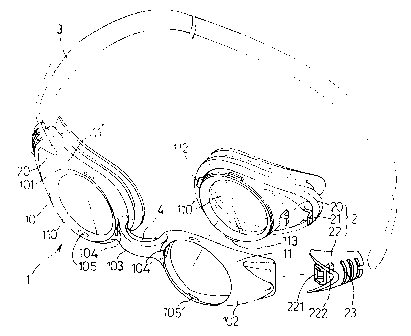Une partie des informations de ce site Web a été fournie par des sources externes. Le gouvernement du Canada n'assume aucune responsabilité concernant la précision, l'actualité ou la fiabilité des informations fournies par les sources externes. Les utilisateurs qui désirent employer cette information devraient consulter directement la source des informations. Le contenu fourni par les sources externes n'est pas assujetti aux exigences sur les langues officielles, la protection des renseignements personnels et l'accessibilité.
L'apparition de différences dans le texte et l'image des Revendications et de l'Abrégé dépend du moment auquel le document est publié. Les textes des Revendications et de l'Abrégé sont affichés :
| (12) Brevet: | (11) CA 2314593 |
|---|---|
| (54) Titre français: | LUNETTES DE NAGE |
| (54) Titre anglais: | SWIMMING GOGGLES |
| Statut: | Périmé et au-delà du délai pour l’annulation |
| (51) Classification internationale des brevets (CIB): |
|
|---|---|
| (72) Inventeurs : |
|
| (73) Titulaires : |
|
| (71) Demandeurs : |
|
| (74) Agent: | OYEN WIGGS GREEN & MUTALA LLP |
| (74) Co-agent: | |
| (45) Délivré: | 2004-02-10 |
| (22) Date de dépôt: | 2000-07-26 |
| (41) Mise à la disponibilité du public: | 2001-07-10 |
| Requête d'examen: | 2000-07-26 |
| Licence disponible: | S.O. |
| Cédé au domaine public: | S.O. |
| (25) Langue des documents déposés: | Anglais |
| Traité de coopération en matière de brevets (PCT): | Non |
|---|
| (30) Données de priorité de la demande: | ||||||
|---|---|---|---|---|---|---|
|
The invention provides a new type of swimming goggles, characterized in that:
a binding frame is used for assembling the main lens frames. The binding frame
includes left and right frame units and a nose bridge that combines the left
and right
frame units. On the left and right frame units near the nose bridge is at
least one clasp
unit. On the main frame unit corresponding to the clasp unit is a clasp piece.
On one
side of the left and right frame units away from the nose bridge is an
assembling
device, thus with the coordinative assembly of the clasp unit, clasp piece and
the
assembling device, the main frame unit can be securely fastened onto the
binding
frame.
Note : Les revendications sont présentées dans la langue officielle dans laquelle elles ont été soumises.
Note : Les descriptions sont présentées dans la langue officielle dans laquelle elles ont été soumises.

2024-08-01 : Dans le cadre de la transition vers les Brevets de nouvelle génération (BNG), la base de données sur les brevets canadiens (BDBC) contient désormais un Historique d'événement plus détaillé, qui reproduit le Journal des événements de notre nouvelle solution interne.
Veuillez noter que les événements débutant par « Inactive : » se réfèrent à des événements qui ne sont plus utilisés dans notre nouvelle solution interne.
Pour une meilleure compréhension de l'état de la demande ou brevet qui figure sur cette page, la rubrique Mise en garde , et les descriptions de Brevet , Historique d'événement , Taxes périodiques et Historique des paiements devraient être consultées.
| Description | Date |
|---|---|
| Le délai pour l'annulation est expiré | 2010-07-26 |
| Lettre envoyée | 2009-07-27 |
| Déclaration du statut de petite entité jugée conforme | 2007-07-18 |
| Inactive : CIB de MCD | 2006-03-12 |
| Accordé par délivrance | 2004-02-10 |
| Inactive : Page couverture publiée | 2004-02-09 |
| Préoctroi | 2003-11-26 |
| Inactive : Taxe finale reçue | 2003-11-26 |
| Un avis d'acceptation est envoyé | 2003-08-14 |
| Un avis d'acceptation est envoyé | 2003-08-14 |
| Lettre envoyée | 2003-08-14 |
| Inactive : Approuvée aux fins d'acceptation (AFA) | 2003-06-25 |
| Modification reçue - modification volontaire | 2002-11-13 |
| Inactive : Dem. de l'examinateur par.30(2) Règles | 2002-07-25 |
| Inactive : Page couverture publiée | 2001-07-13 |
| Demande publiée (accessible au public) | 2001-07-10 |
| Inactive : CIB en 1re position | 2000-10-13 |
| Exigences de dépôt - jugé conforme | 2000-08-23 |
| Inactive : Certificat de dépôt - RE (Anglais) | 2000-08-23 |
| Demande reçue - nationale ordinaire | 2000-08-22 |
| Toutes les exigences pour l'examen - jugée conforme | 2000-07-26 |
| Exigences pour une requête d'examen - jugée conforme | 2000-07-26 |
Il n'y a pas d'historique d'abandonnement
Le dernier paiement a été reçu le 2003-07-16
Avis : Si le paiement en totalité n'a pas été reçu au plus tard à la date indiquée, une taxe supplémentaire peut être imposée, soit une des taxes suivantes :
Veuillez vous référer à la page web des taxes sur les brevets de l'OPIC pour voir tous les montants actuels des taxes.
| Type de taxes | Anniversaire | Échéance | Date payée |
|---|---|---|---|
| Taxe pour le dépôt - petite | 2000-07-26 | ||
| Requête d'examen - petite | 2000-07-26 | ||
| TM (demande, 2e anniv.) - petite | 02 | 2002-07-26 | 2002-07-12 |
| TM (demande, 3e anniv.) - petite | 03 | 2003-07-28 | 2003-07-16 |
| Taxe finale - petite | 2003-11-26 | ||
| TM (brevet, 4e anniv.) - petite | 2004-07-26 | 2004-06-30 | |
| TM (brevet, 5e anniv.) - petite | 2005-07-26 | 2005-06-29 | |
| TM (brevet, 6e anniv.) - petite | 2006-07-26 | 2006-06-21 | |
| TM (brevet, 7e anniv.) - petite | 2007-07-26 | 2007-07-18 | |
| TM (brevet, 8e anniv.) - petite | 2008-07-28 | 2008-07-07 |
Les titulaires actuels et antérieures au dossier sont affichés en ordre alphabétique.
| Titulaires actuels au dossier |
|---|
| HERMAN CHIANG |
| Titulaires antérieures au dossier |
|---|
| S.O. |